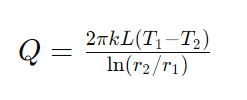Vessel Heat Loss Calculator
Introduction
Calculating heat loss in vessels is crucial for various industries to optimize energy usage and maintain operational efficiency. A vessel heat loss calculator simplifies this process, providing accurate results for informed decision-making.
How to Use
Using the vessel heat loss calculator is straightforward. Enter the required parameters such as vessel dimensions, material properties, and operating conditions into the designated fields. Then, click the “Calculate” button to obtain the heat loss value.
Formula
The formula used for calculating heat loss in vessels is based on the principles of thermal conduction and convection. The most accurate formula for this calculation is the following:

Where:
- Q is the heat loss (W)
- k is the thermal conductivity of the material (W/mK)
- L is the length of the vessel (m)
- T1 and T2 are the temperatures at the inner and outer surfaces of the vessel respectively (°C)
- r1 and r2 are the inner and outer radii of the vessel respectively (m)
Example Solve
Let’s consider a cylindrical vessel with the following parameters:
- Length (L) = 2 m
- Inner radius (r1) = 0.5 m
- Outer radius (r2) = 0.6 m
- Thermal conductivity (k) = 25 W/mK
- Inner surface temperature (T1) = 150°C
- Outer surface temperature (T2) = 30°C
Plugging these values into the formula:


Q≈4521.95W
So, the heat loss from the vessel is approximately 4521.95 Watts.
FAQs
1. How accurate is the vessel heat loss calculator?
The calculator provides accurate results based on the input parameters and the specified formula.
2. Can the calculator handle different shapes of vessels?
Currently, the calculator is designed for cylindrical vessels, but it can be adapted for other shapes with appropriate formulas.
Conclusion
A vessel heat loss calculator is a valuable tool for industries concerned with energy efficiency and process optimization. By accurately estimating heat loss, companies can implement effective insulation strategies and minimize energy costs.
